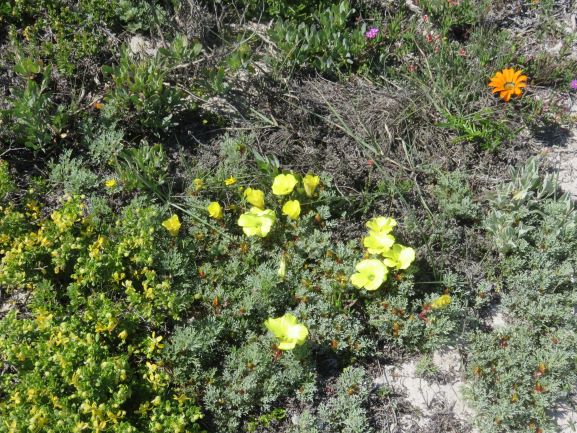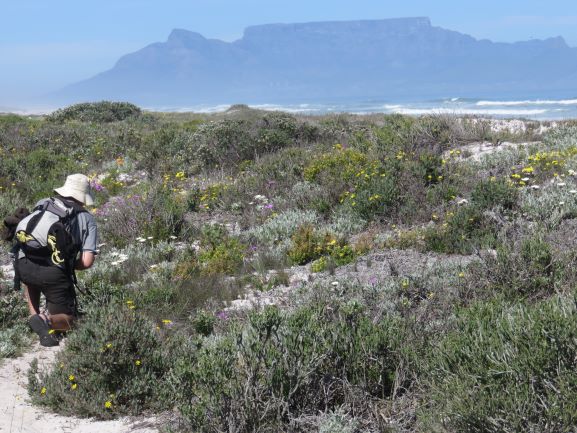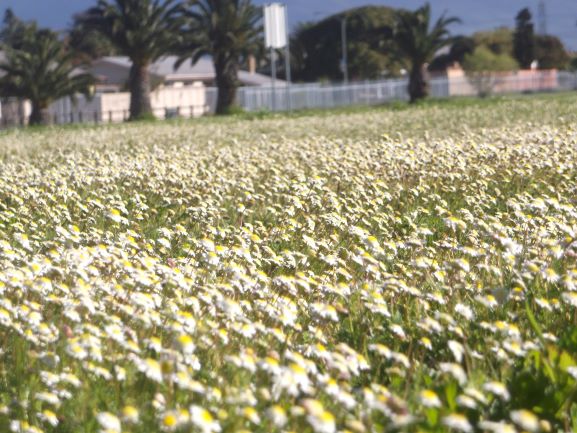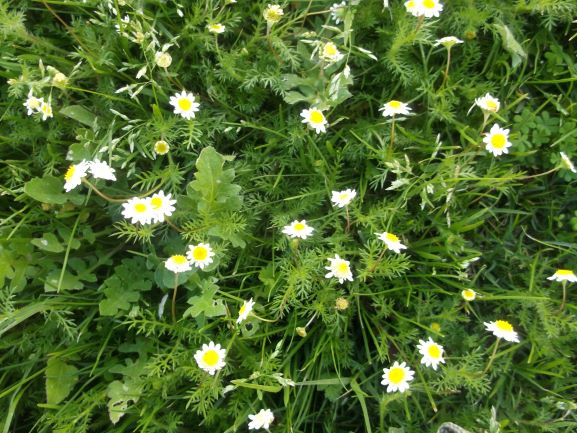Dear Reader, in this age of AI created content, please support with your goodwill someone who works harder to provide the human-made. Sign up at the top of the lefthand column or bottom of this page. You will receive my hand illustrated monthly newsletter RESTORE NATURE and access to the biodiversity garden design course as I write...and nothing else, I respect your time. I am also removing the advertizing as best I can as its become intrusive inappropriate and pays me nothing.
Bringing gorgeous diversity into lawn design
Cutting edge English lawn design allows you to have a luscious green lawn with no grass by replacing it with a tapestry of ground cover and flowers, that can be mowed when you wish, reducing lawn care to a minimum.
This innovative lawn design method is based on the PhD thesis of Lionel Smith, a post graduate student at the University of Reading in the UK.
The research involved planting several experimental lawns which culminated in public plantings of lawns which design grass completely out of the process and replace it with flowering ground covers that can take mowing.
 Our local dune vegetation tends to be flat, showing huge tapestry lawn potential. For pictures of the English lawns, see the links at the bottom of the page.
Our local dune vegetation tends to be flat, showing huge tapestry lawn potential. For pictures of the English lawns, see the links at the bottom of the page.Weed control in lawns
In these new lawns, or rather lawns that are based on wild vegetation and are thus not so new, flowering ground covers are close planted and then allowed to self propagate. The lawns are mown from time to time. In this system weeds are crowded out and or mowed down. There is no need for herbicide. In the parks near my home the flowers which grow in the grass are mowed. Up close the park's green surface is incredibly diverse. Once one is used to the richness of the variety of greens in the lawn, the perfect bowling green type of lawn is simply boring by comparison, even crude.
Not just lawns but living carpets of diversity
There is no law saying a mowed lawn must consist only of grass. The origin of lawns in the monastic paradisium was in a flowered sward, green velvet dotted with the stars of meadow flowers.
Tapestry lawns with no grass at all show a large increase in pollinator visits and variety, even compared to meadow with flowers, which is better than lawn monocultures.
Natural lawn design
Unlike conventional grass monoculture lawns, tapestry lawns are an asset to the ecology of the garden, and a blessing when the dry season comes.
In this type of lawn, indigenous and hardy plants are welcome. Much of our local native flora needs no coercion to become a green or soft olive gray carpet, it is its natural state. The Cape is more richly endowed with flowers than most regions of the world. Our local plants would make perfect material for the type of tapestry lawn designs being birthed in England.
They would also do a lot to ameliorate the drought we are experiencing regularly.
 nature doing the tapestry thing for itself
nature doing the tapestry thing for itselfMost of our public parks use mixed grass and wild plants or weeds. To best accommodate our local low nutrient
preferring vegetation, no fertilizers should be spread on these public
lawns, and no weed killers used, and they will flower profusely in
gratitude. However, mowing by the city should be timed to allow the flowering plants to propagate by seed.
These parks are gorgeous in the spring time. The problem is that in high summer the vegetation dies back and exposes the soil which blows around causing erosion. I have documented this photographically in the northern suburbs. If they mixed in some more low growing perennials instead of only having grass, annuals and geophyte ground cover species the earth could have cover in all seasons. This would preserve soil moisture and save our soil.
 Flowers in the grass. Oxalis obtusa ?
Flowers in the grass. Oxalis obtusa ?Replace lawn
We can entirely replace our lawns
of alien grass. They are a luxury we can't afford. Most need intensive maintenance, including watering, in this thirsty
drought stricken country. We should replace the kikuyu which dies in
summer exposing the sand of the Cape Flats to the blistering sun and
desiccation. We should plant perennial ground covers on all street verges and open pieces of land and not plant kikuyu. Beyond exposing the soil in high summer when it dies back, kikuyu is highly invasive and one of the biggest killers of our local vegetation. In many places you can see it swamping the low Renosterveld or fynbos bushes, growing right over the top of them like a blanket, to produce tatty hummocks, .
 A cornucopia of drought hardy dune land diversity
A cornucopia of drought hardy dune land diversityGreen lawn for those who love the environment
You can have luxurious green lawn without grass. Take a look at some of my albums on local ground covers that replace lawn with grace. The English links I have supplied will show plants more suited to Europe.
 walking on stars (possibly 2 Romulea varieties ?). The linear leaves are not grass, but their foliage. It obviously tolerates mowing.
walking on stars (possibly 2 Romulea varieties ?). The linear leaves are not grass, but their foliage. It obviously tolerates mowing.Organic lawn care
The best organic lawn care is no care at all, by going native. Perhaps in other climes, a little compost should suffice to keep the lawn lush, but for our flora fertilization is usually a no-no. See the English links for more information on lawn care in the north.
 Another mown variety, possibly also Romulea ? miniscule with more foliage
Another mown variety, possibly also Romulea ? miniscule with more foliageIn praise of Tapestry lawns
I hope these beautiful tapestry lawn designs will take over the world. It will have a much more beneficial ecological effect than the first English lawn fashion which took over in the nineteen forties. Green perfectly mown lawn originated in English country estates, and came to dominate garden design worldwide, despite not being suited to many other climates. Now people like Lionel Smith are fixing it, and lets embrace it.
------
------
Wild plants, for aesthetic enjoyment, environmental care and food
------
------
English website and blog on Tapestry lawns
------
The English tapestry lawn leaf up close
------
------
Restore Nature Newsletter
I've been writing for four years now and I would love to hear from you
Please let me know if you have any questions, comments or stories to share on gardening, permaculture, regenerative agriculture, food forests, natural gardening, do nothing gardening, observations about pests and diseases, foraging, dealing with and using weeds constructively, composting and going offgrid.
What Other Visitors Have Said
Click below to see contributions from other visitors to this page...
Ms Kim-Marie Fisser 




I'm just blown away by yr article. I've only recently discovered the term 'lawn tapestry' & indeed,info on the subject. I'm extremely excited by the whole …
SEARCH
Order the Kindle E-book for the SPECIAL PRICE of only
Prices valid till 30.09.2023
Recent Articles
-
garden for life is a blog about saving the earth one garden at a time
Apr 18, 25 01:18 PM
The garden for life blog has short articles on gardening for biodiversity with native plants and regenerating soil for climate amelioration and nutritious food -
Cape Flats Sand Fynbos, Cape Town's most endangered native vegetation!
Apr 18, 25 10:36 AM
Cape Flats Sand Fynbos, a vegetation type found in the super diverse Cape Fynbos region is threatened by Cape Town's urban development and invasive alien plants -
Geography Research Task
Jan 31, 25 11:37 PM
To whom it may concern My name is Tanyaradzwa Madziwa and I am a matric student at Springfield Convent School. As part of our geography syllabus for this
"How to start a profitable worm business on a shoestring budget
Order a printed copy from "Amazon" at the SPECIAL PRICE of only
or a digital version from the "Kindle" store at the SPECIAL PRICE of only
Prices valid till 30.09.2023











